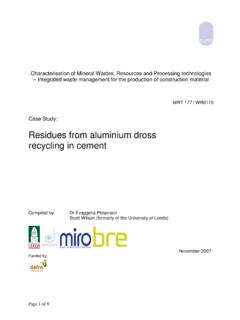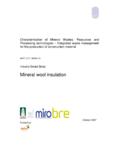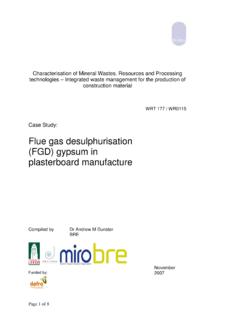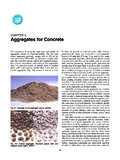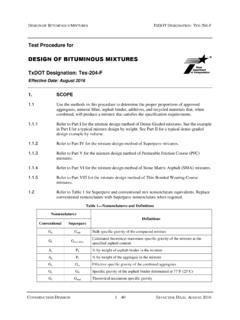Transcription of BITUBLOCK – A novel construction unit using 100% waste ...
1 1 Characterisation of Mineral Wastes, Resources and Processing technologies Integrated waste management for the production of construction material WRT 177 / WR0115 Case Study: BITUBLOCK A novel construction unit using 100% waste derived aggregate Compiled by John Barton University of Leeds Funded by: October 2007 2 Introduction BITUBLOCK (Fig 1) is a novel construction unit which can be composed entirely of recycled and waste aggregates bound in a matrix of bitumen. The product is not yet in full commercial production but extensive testing (Fig 2) and verification of properties have demonstrated excellent potential for substituting for concrete and clay based building block products. One of the key features relevant to future success lies in the ability to select the input recipe ingredients and process conditions to match and in many cases exceed current specifications for a range of products / end uses.
2 This flexibility gives BITUBLOCK a justifiable claim to be viewed as a novel product rather than just a substitute for existing construction units. Figure 1: BITUBLOCK Figure 2: Testing a BITUBLOCK wall The research has also demonstrated that the requisite properties of the waste used ( particle size, strength) can be defined in a fit for purpose functional manner which opens up the range of potentially suitable waste material inputs for example: recycled glass Incinerated sewage sludge ash (ISSA) Quarry fines Municipal Solid waste Incinerator bottom ash (MSWI BA) construction and demolition waste and other recycled aggregate Again this is likely to be an important feature for commercialisation of the technology as the blocks can be manufactured from locally sourced wastes and the risks associated with continuity of supply are diminished.
3 3 The manufacturing process The recipe for BITUBLOCK normally requires a mix of coarse (~10-20mm), fine ( 2mm) and filler (< ) particles, the ratios being dependent on the feedstock material and desired product properties. Essentially the ratios determine the packing characteristics and hence the initial voidage and bulk density of the aggregate mix. The material strengths, particular of the coarse aggregate will influence the final block strength. The porosity of the aggregate materials has a key bearing on the proportion of bitumen required for a cohesive product. High porosities require higher proportions of binder to achieve equivalent block properties. Following conditioning (control of moisture content), the aggregates and binder are mixed and the blocks pressed in an appropriately sized / shaped mould.
4 The blocks are then heat cured to achieve their final product characteristics. Curing temperature, duration and type of binder affect the final strength of the blocks but essentially the oxidation of the bitumen results in the blocks setting as hard as concrete . To date two main types of bitumen binder have been assessed, hot melt and emulsion bitumen, with varying natural initial hardness (penetration grade). Potential applications for BITUBLOCK Potential uses of these blocks focus on the existing markets for load and non-load bearing construction units such as concrete and clay based building blocks in both internal and external applications. Apart from the important structural properties such as porosity, density, compressive strength, creep and durability, other properties such as insulation and fire resistance may be of interest.
5 Technically it would appear that performance requirements to achieve high substitution rates for the conventional products can be met, though clearly in an industry conscious of long term liabilities associated with buildings, demonstrating technical equivalence does not automatically gain industry acceptance of a novel product. On the positive side, the Blocks have achieved very high recycled content and the manufacturing energy input (relative to cement and brick making) is low giving the blocks a low Carbon footprint overall. Both these factors are attractive to an industry increasingly conscious of their environmental credentials and when seeking practical solutions to policy initiatives such as the UK government s sustainable construction strategy currently out for consultation.
6 These markets are clearly high volume, low added value markets with a potential capacity demand that could well exceed the availability of suitable wastes for BITUBLOCK manufacturer (for example, some 350 million concrete blocks are manufactured in the UK each year). Furthermore, although not to the same extent, both concrete and clay block manufacturers have a capability to substitute some of their raw materials for waste and many of the waste materials tested, crushed glass, have alternative recycling outlets. Thus any raw material cost advantage offered by utilising high proportions of waste must also be matched by low / 4 competitive manufacturing cost. The utilisation of the blocks is not expected to increase building costs. This is an important issue for the final users and tests (Fig 2) have indicated they will not be faced by additional on-site problems ( in terms of handling & storage, methods of fixing blocks together and to other building components(mortar/mastic/bolts) Barriers and Benefits ( waste product pairing) Commentary on generic constraints and benefits covering the five main topic headings: Material related High porosity feed materials can lead to higher bitumen use, up to 10% compared to more typically 6% overall.)
7 Overall the type of product and the ability to adapt process conditions appears highly suited to a wide range of wastes and the more inconsistent nature of waste characteristics. This is particularly for the functional replacement of the fine and filler components. Legal Majority of inputs will continue to be defined as a waste and therefore the manufacturing process and the inputs will be subject to waste management regulations. Possible future changes due to product quality protocols may make current potential waste inputs (particularly for the course aggregate function) more attractive to other sectors / products. Economic Although there may be short term green preference markets, the product will have to compete on price with other construction blocks.
8 Benefits of low carbon footprint and high recycled content generate price advantages ( Climate Change Levy on cement and brick industries, Aggregates Levy, avoided Landfill Tax) and these benefits are likely to improve over time. Environmental Low Carbon Footprint and up to 100% recycled content. Suitable wastes for incorporation into this product are widely available and hence production can be envisaged in most areas with a demand for construction blocks. Heavy metals may be present in some of the substitute aggregate wastes. 5 Organisational The greatest barrier is the general conservative nature of the construction sector; this cannot be fully tackled without blocks going into production on a significant scale. This investment will be of higher risk than for more conventional production capacity.
9 Specific product characterisation results waste inputs No single standard exist for the wide range of waste types that might be incorporated into the BITUBLOCK product but all are currently directive wastes (some hazardous wastes) and the process will need to have a waste management license. Table 1 illustrates some of the key parameter values of interest and the function waste inputs are providing in terms of aggregate size. Table1: Materials used in BITUBLOCK mixtures Material Density (Mg/m3) Water absorption % Utilisation Crushed glass <1 Coarse and fine aggregate Steel slag coarse aggregate Furnace Bottom Ash FBA Fine aggregate Pulverised Fuel Ash PFA - Filler Coarse incinerator bottom ash IBA Coarse aggregate Fine Incinerator bottom ash IBA Fine aggregate Incinerated sewage sludge ash ISSA Filler and fine aggregate Bitumen binder The Bitumen is the most expensive input to the product and hence minimum percentage inputs for a given end-product specification is aimed for.
10 The key functional requirement of the binder is to thinly coat the aggregate without too great a level of penetration of porous materials. Initial flow characteristics are important as these determine, along with the aggregate, the ability to form a cohesive product with sufficient green strength to withstand handling prior to curing. The second function of the binder is to harden with age to ensure requisite compressive strengths are achieved. For bitumen, heat curing between 100 and 200oC for up to 2 days will oxidise the bitumen and the block sets like concrete. Product and testing Bitublocks have been subjected to a range of physical and chemical testing methods commonly applied to the concrete / clay based block products as part of standard or industry based specification requirements.



